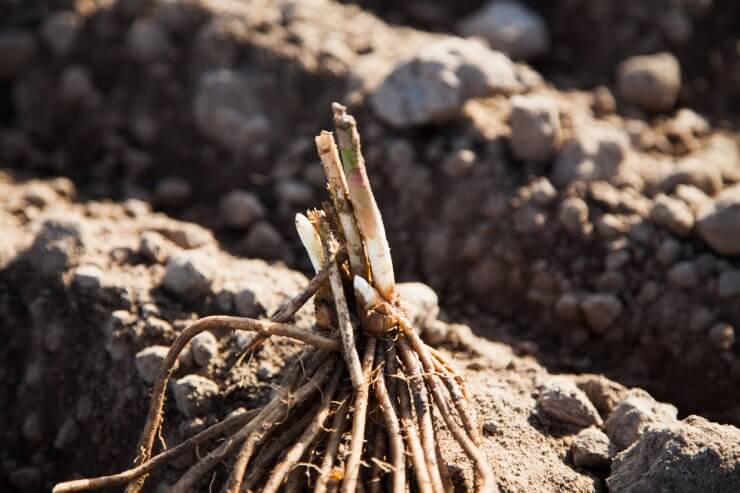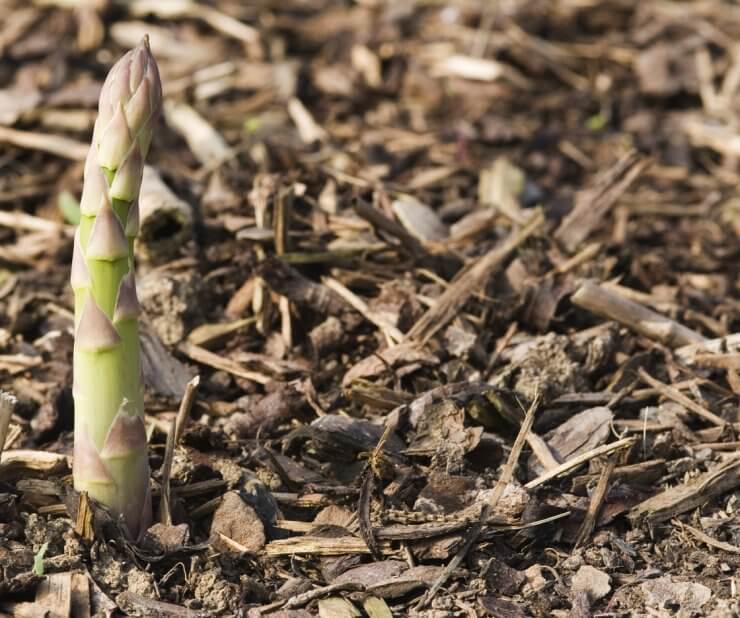
Asparagus crown ready to be planted
Planting Your Asparagus
Getting your asparagus garden started begins with the choice of how to grow your plants—from seeds or crowns (1-year-old roots). It’s more economical to start your asparagus plants from seeds, but you will have an easier time establishing your asparagus plants and will have an edible harvest a year sooner when you plant crowns.
If you plan to grow asparagus from seeds, the first thing you’ll need is patience. Asparagus is a slow-growing plant to begin with—so, starting from seed will add a year to the amount of time you’ll have to wait for a harvest.
With that timeline in mind, start the seeds indoors or in a greenhouse in mid-February to early May under bright lights. Soil must be 70 to 85 degrees F for the seeds to germinate. Soak the seeds for a couple of hours, then plant them in sterile soil 1/2-inch deep in individual pots. Sprouts should appear in two to eight weeks.
Seedlings are ready to plant in prepared, weed-free soil when they are 10 to 12 weeks old. Space them 18 inches apart in rows that are 3 to 6 inches apart. As the crown grows, cover it with soil and water once a week. Weed religiously as the young asparagus plants need lots of nutrients and can’t handle the competition. Remember, do not harvest stalks for the first three years, but do cut the ferns down to 2 inches in the late fall.
Planting asparagus crowns will give you a leg up on your asparagus growth. Crown plantings are also easier to grow and maintain. Purchase your crowns when they are available, in early spring. Make sure your bed is weed-free and amended with a generous amount of compost. Dig a trench about 6 inches deep and 8 inches wide. At 18-inch intervals, place a crown at the bottom of the trench, with the buds on top and roots spread out. Cover with 2 inches of topsoil and add water.
As the young shoots (spears) appear, add more soil to the trench, avoiding covering the foliage. Repeat adding soil to the trench 2 or 3 more times as the shoots grow until they are 10 to 12 inches high. The trench should be full by the end of the growing season. Water weekly until the soil is moistened 8 to 12 inches deep. And keep weeding!
Do not harvest the first year; in the second year, you may harvest sparingly. By the third year you should have a healthy crop of asparagus that will continue yielding for a generation or more with very little attention needed.
Pruning Your Asparagus

Mulched for winter, asparagus begins to appear in spring
Pruning asparagus plants is important to strengthening the crown and root system. Fortunately pruning asparagus is easy to do.
Pruning takes place in the late fall, after the foliage has died back and turned brown or yellow, usually after the first frost. Cut the foliage back to 2 inches and apply mulch around the plant to keep the roots warm during the winter.
In the spring, check your asparagus beds. Cut off the old tops before new shoots start to appear.
Please tell us about your asparagus planting and pruning techniques in the comment section below. Have you faced any challenges with planting or pruning your asparagus? How have you handled it? Please comment below and share your experiences.


 Previous
Previous


I have planted asparagus 2 years ago and would like to transplant them into a more sunny area with more growing space as well. Is that a good idea? How do they tolerate being moved? Last summer the stalks were very thin (about 1/4″ -1/2″) and about 3′ tall.
I have an all year greenhouse. It is now winter and I would like to plant asparagus in pots in the greenhouse and leave some there and then plant some outside in spring. Will they grow and continue to grow in a greenhouse in pots?
Thanks Paul
Sorry to ask that ? About planting. I now see the rest of the info.
No worries. I hope you enjoy all our great content.